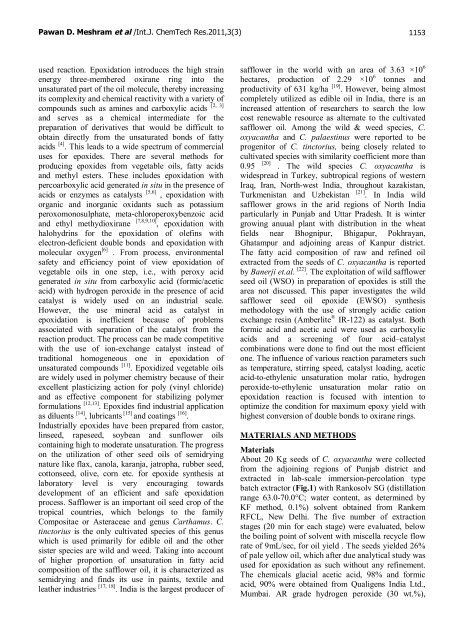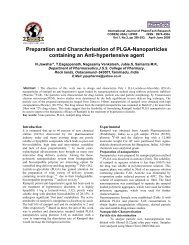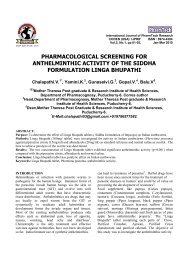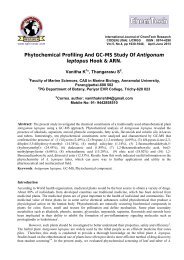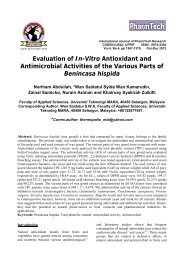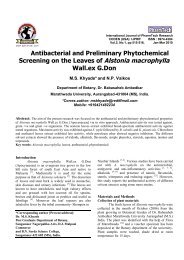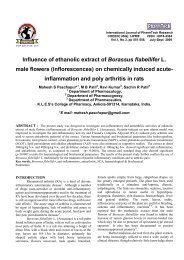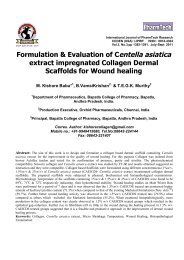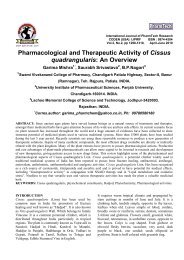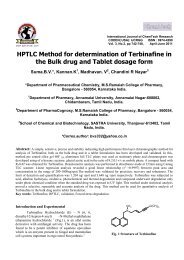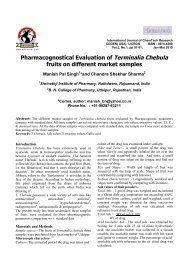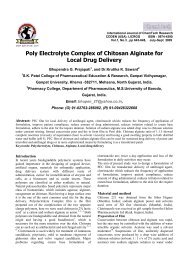epoxidation of wild safflower (carthamus oxyacantha) - Research ...
epoxidation of wild safflower (carthamus oxyacantha) - Research ...
epoxidation of wild safflower (carthamus oxyacantha) - Research ...
You also want an ePaper? Increase the reach of your titles
YUMPU automatically turns print PDFs into web optimized ePapers that Google loves.
Pawan D. Meshram et al /Int.J. ChemTech Res.2011,3(3) 1153<br />
used reaction. Epoxidation introduces the high strain<br />
energy three-membered oxirane ring into the<br />
unsaturated part <strong>of</strong> the oil molecule, thereby increasing<br />
its complexity and chemical reactivity with a variety <strong>of</strong><br />
compounds such as amines and carboxylic acids<br />
[2, 3]<br />
and serves as a chemical intermediate for the<br />
preparation <strong>of</strong> derivatives that would be difficult to<br />
obtain directly from the unsaturated bonds <strong>of</strong> fatty<br />
acids [4] . This leads to a wide spectrum <strong>of</strong> commercial<br />
uses for epoxides. There are several methods for<br />
producing epoxides from vegetable oils, fatty acids<br />
and methyl esters. These includes <strong>epoxidation</strong> with<br />
percoarboxylic acid generated in situ in the presence <strong>of</strong><br />
acids or enzymes as catalysts [5,6] , <strong>epoxidation</strong> with<br />
organic and inorganic oxidants such as potassium<br />
peroxomonosulphate, meta-chloroperoxybenzoic acid<br />
and ethyl methydioxirane [7,8,9,10] , <strong>epoxidation</strong> with<br />
halohydrins for the <strong>epoxidation</strong> <strong>of</strong> olefins with<br />
electron-deficient double bonds and <strong>epoxidation</strong> with<br />
molecular oxygen [6] . From process, environmental<br />
safety and efficiency point <strong>of</strong> view <strong>epoxidation</strong> <strong>of</strong><br />
vegetable oils in one step, i.e., with peroxy acid<br />
generated in situ from carboxylic acid (formic/acetic<br />
acid) with hydrogen peroxide in the presence <strong>of</strong> acid<br />
catalyst is widely used on an industrial scale.<br />
However, the use mineral acid as catalyst in<br />
<strong>epoxidation</strong> is inefficient because <strong>of</strong> problems<br />
associated with separation <strong>of</strong> the catalyst from the<br />
reaction product. The process can be made competitive<br />
with the use <strong>of</strong> ion-exchange catalyst instead <strong>of</strong><br />
traditional homogeneous one in <strong>epoxidation</strong> <strong>of</strong><br />
unsaturated compounds [11] . Epoxidized vegetable oils<br />
are widely used in polymer chemistry because <strong>of</strong> their<br />
excellent plasticizing action for poly (vinyl chloride)<br />
and as effective component for stabilizing polymer<br />
formulations [12,13] . Epoxides find industrial application<br />
as diluents [14] , lubricants [15] and coatings [16] .<br />
Industrially epoxides have been prepared from castor,<br />
linseed, rapeseed, soybean and sunflower oils<br />
containing high to moderate unsaturation. The progress<br />
on the utilization <strong>of</strong> other seed oils <strong>of</strong> semidrying<br />
nature like flax, canola, karanja, jatropha, rubber seed,<br />
cottonseed, olive, corn etc. for epoxide synthesis at<br />
laboratory level is very encouraging towards<br />
development <strong>of</strong> an efficient and safe <strong>epoxidation</strong><br />
process. Safflower is an important oil seed crop <strong>of</strong> the<br />
tropical countries, which belongs to the family<br />
Compositae or Asteraceae and genus Carthamus. C.<br />
tinctorius is the only cultivated species <strong>of</strong> this genus<br />
which is used primarily for edible oil and the other<br />
sister species are <strong>wild</strong> and weed. Taking into account<br />
<strong>of</strong> higher proportion <strong>of</strong> unsaturation in fatty acid<br />
composition <strong>of</strong> the <strong>safflower</strong> oil, it is characterized as<br />
semidrying and finds its use in paints, textile and<br />
leather industries [17, 18] . India is the largest producer <strong>of</strong><br />
<strong>safflower</strong> in the world with an area <strong>of</strong> 3.63 ×10 6<br />
hectares, production <strong>of</strong> 2.29 ×10 6 tonnes and<br />
productivity <strong>of</strong> 631 kg/ha [19] . However, being almost<br />
completely utilized as edible oil in India, there is an<br />
increased attention <strong>of</strong> researchers to search the low<br />
cost renewable resource as alternate to the cultivated<br />
<strong>safflower</strong> oil. Among the <strong>wild</strong> & weed species, C.<br />
<strong>oxyacantha</strong> and C. palaestinus were reported to be<br />
progenitor <strong>of</strong> C. tinctorius, being closely related to<br />
cultivated species with similarity coefficient more than<br />
0.95 [20] . The <strong>wild</strong> species C. <strong>oxyacantha</strong> is<br />
widespread in Turkey, subtropical regions <strong>of</strong> western<br />
Iraq, Iran, North-west India, throughout kazakistan,<br />
Turkmenistan and Uzbekistan [21] . In India <strong>wild</strong><br />
<strong>safflower</strong> grows in the arid regions <strong>of</strong> North India<br />
particularly in Punjab and Uttar Pradesh. It is winter<br />
growing anuual plant with distribution in the wheat<br />
fields near Bhognipur, Bhigapur, Pokhrayan,<br />
Ghatampur and adjoining areas <strong>of</strong> Kanpur district.<br />
The fatty acid composition <strong>of</strong> raw and refined oil<br />
extracted from the seeds <strong>of</strong> C. <strong>oxyacantha</strong> is reported<br />
by Banerji et.al. [22] . The exploitation <strong>of</strong> <strong>wild</strong> <strong>safflower</strong><br />
seed oil (WSO) in preparation <strong>of</strong> epoxides is still the<br />
area not discussed. This paper investigates the <strong>wild</strong><br />
<strong>safflower</strong> seed oil epoxide (EWSO) synthesis<br />
methodology with the use <strong>of</strong> strongly acidic cation<br />
exchange resin (Amberlite ® IR-122) as catalyst. Both<br />
formic acid and acetic acid were used as carboxylic<br />
acids and a screening <strong>of</strong> four acid–catalyst<br />
combinations were done to find out the most efficient<br />
one. The influence <strong>of</strong> various reaction parameters such<br />
as temperature, stirring speed, catalyst loading, acetic<br />
acid-to-ethylenic unsaturation molar ratio, hydrogen<br />
peroxide-to-ethylenic unsaturation molar ratio on<br />
<strong>epoxidation</strong> reaction is focused with intention to<br />
optimize the condition for maximum epoxy yield with<br />
highest conversion <strong>of</strong> double bonds to oxirane rings.<br />
MATERIALS AND METHODS<br />
Materials<br />
About 20 Kg seeds <strong>of</strong> C. <strong>oxyacantha</strong> were collected<br />
from the adjoining regions <strong>of</strong> Punjab district and<br />
extracted in lab-scale immersion-percolation type<br />
batch extractor (Fig.1) with Rankosolv SG (distillation<br />
range 63.0-70.0°C; water content, as determined by<br />
KF method, 0.1%) solvent obtained from Rankem<br />
RFCL, New Delhi. The five number <strong>of</strong> extraction<br />
stages (20 min for each stage) were evaluated, below<br />
the boiling point <strong>of</strong> solvent with miscella recycle flow<br />
rate <strong>of</strong> 9mL/sec, for oil yield . The seeds yielded 26%<br />
<strong>of</strong> pale yellow oil, which after due analytical study was<br />
used for <strong>epoxidation</strong> as such without any refinement.<br />
The chemicals glacial acetic acid, 98% and formic<br />
acid, 90% were obtained from Qualigens India Ltd.,<br />
Mumbai. AR grade hydrogen peroxide (30 wt.%),


